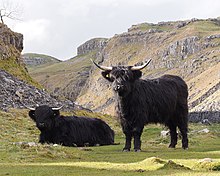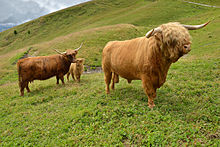Highland cattle
| Other names |
|
|---|---|
| Country of origin | Scotland |
| Distribution | worldwide |
| Standard | The Highland Cattle Society |
| Use | meat |
| Traits | |
| Weight | |
| Height | |
| Coat |
|
| Horn status | horned in both sexes |
The Highland (
History



The Highland is a traditional breed of western Scotland. There were two distinct types. The Kyloe, reared mainly in the Hebrides or Western Islands, was small and was frequently black.[5]: 243 The cattle were so called because of the practice of swimming them across the narrow straits or kyles separating the islands from the mainland. The cattle of the mainland were somewhat larger, and very variable in colour; they were often brown or red.[6]: 200 [7]: 66
These cattle were important to the Scottish economy of the eighteenth century. At markets such as those of Falkirk or Crieff, many were bought by drovers from England, who moved them south over the Pennines to be fattened for slaughter. In 1723 over 30000 Scottish cattle were sold into England.[5]: 243
A
In 2002 the number of registered breeding cows in the United Kingdom was about 2500; by 2012 this had risen to some 6000.[6]: 200 In 2021 it was 3161; the conservation status of the breed in the United Kingdom is listed in DAD-IS as endangered/at risk.[2] The number of unregistered cattle is not known.[6]: 200
Although a group of cattle is generally called a herd, a group of Highland cattle is known as a "fold". This is because in winter, the cattle were kept in open shelters made of stone called folds to protect them from the weather at night.[8]
In 1954,


From the late nineteenth century, stock was exported to various countries of the world, among them Argentina, Australia, Canada, the Falkland Islands, the former Soviet Union and the United States.[6]: 200 Later in the twentieth century there were exports to various European countries.[6]: 200 In 2022 the breed was reported to DAD-IS by twenty-three countries, of which seventeen reported population data. The total population world-wide was reported at just over 40000, with the largest numbers in France and Finland.[11]
Australia
Highland cattle were first imported into Australia by the mid-nineteenth century by Scottish migrants such as Chieftain Aeneas Ronaldson MacDonell of Glengarry, Scotland. Arriving in Port Albert, Victoria, in 1841 with his clan, they apparently drove their Highland cattle to a farm at Greenmount, on the Tarra River, preceded by a piper. Samuel Amess, also from Scotland, who made a fortune in the Victorian goldfields and became Mayor of Melbourne in 1869, kept a small fold of black Highland cattle on Churchill Island. They were seen and survived in Port Victoria during the late 1800s, but other folds were believed to have died out in areas such as New South Wales. In 1988 the Australian Highland Cattle Society was formed. Since then, numbers have been growing and semen is being exported to New Zealand to establish the breed there.
Canada
Highland cattle were first imported into Canada in the 1880s. The Hon. Donald A. Smith,
Denmark
The Danish Highland Cattle Society was established in 1987 to promote the best practices for the breeding and care of Highland cattle and to promote the introduction of the breed into Denmark.[16]
Finland
The Highland Cattle Club of Finland was founded in 1997. Their studbooks show importation of Highland cattle breeding stock to Finland, dating back to 1884. The Finnish club states that in 2016, there were 13000 Highland cattle in Finland.[17]
United States
The first record of Highland cattle being imported to the United States was in the late 1890s.[18] The American Highland Cattle Association was first organised in 1948 as the American Scotch Highland Breeders Association, and now claims approximately 1100 members.[19]
Characteristics

They have long, wide
They have an unusual double coat of hair. On the outside is the oily outer hair—the longest of any cattle breed, covering a downy undercoat.[21] This makes them well suited to conditions in the Highlands, which have a high annual rainfall and sometimes very strong winds.[22]
Mature bulls can weigh up to 800 kg (1800 lb) and heifers can weigh up to 500 kg (1100 lb). Cows typically have a height of 90–106 cm (35–42 in), and bulls are typically in the range of 106–120 cm (42–47 in).[citation needed] Mating occurs throughout the year with a gestation period of approximately 277–290 days. Most commonly a single calf is born, but twins are not unknown. Sexual maturity is reached at about eighteen months. Highland cattle also have a longer expected lifespan than most other breeds of cattle, up to 20 years.[23]
Cold tolerance
All
Social behaviour
A fold of semi-wild Highland cattle was studied over a period of 4 years. It was found that the cattle have a clear structure and hierarchy of dominance, which reduces aggression. Social standing depends on age and sex, with older cattle being dominant to calves and younger ones, and males dominant to females. Young bulls will dominate adult cows when they reached around 2 years of age. Calves from the top ranking cow were given higher social status, despite minimal intervention from their mother. Playfighting, licking and mounting were seen as friendly contact.[26][27]
Breeding occurred in May and June, with heifers first giving birth at 2–3 years old.[26]
Use
The meat of Highland cattle tends to be leaner than most beef because Highlands are largely insulated by their thick, shaggy hair rather than by subcutaneous fat. Highland cattle can produce beef at a reasonable profit from land that would otherwise normally be unsuitable for agriculture. The most profitable way to produce Highland beef is on poor pasture in their native land, the Highlands of Scotland.[28]
Commercial success
The beef from Highland cattle is very tender, but the market for high-quality meat has declined. To address this decline, it is common practice to breed Highland "suckler" cows with a more favourable breed such as a
See also
- List of domesticated Scottish breeds
References
- ISBN 9789251057629. Archived 23 June 2020.
- ^ a b c d e f Breed data sheet: Highland / United Kingdom of Great Britain and Northern Ireland (Cattle). Domestic Animal Diversity Information System of the Food and Agriculture Organization of the United Nations. Accessed November 2022.
- ^ Watchlist overview. Kenilworth, Warwickshire: Rare Breeds Survival Trust. Accessed December 2021.
- ^ "Highland Cattle Society breed standard". Highlandcattlesociety.com. Archived from the original on 10 May 2015. Retrieved 13 June 2016.
- ^ ISBN 0300088809.
- ^ ISBN 9781780647944.
- ^ James Wilson (1909). The Colours of Highland Cattle. The Scientific Proceedings of the Royal Dublin Society. 12 (New Series): 66–76.
- ^ "Smallholder Series – Cattle Breeds". Archived from the original on 26 September 2017. Retrieved 13 June 2015.
- ^ "Highland Cattle at Balmoral Castle". Archived from the original on 27 April 2015. Retrieved 7 June 2015.
- ^ "Queen to found Highland Cattle fold". Glasgow Herald. 25 February 1954. Retrieved 11 September 2015 – via Google Books.
- ^ Transboundary breed: Highland. Domestic Animal Diversity Information System of the Food and Agriculture Organization of the United Nations. Accessed November 2022.
- ^ "Livestock Conservancy – Highland cattle". Retrieved 4 August 2015.
- ^ "Highland Cattle history in Canada". Canadian Highland Cattle Society. Archived from the original on 29 April 2015. Retrieved 28 April 2015.
- ^ "Canadian Highland Cattle Society". Archived from the original on 28 May 2015. Retrieved 28 May 2015.
- ^ "Highland Cattle World – Canada". Highland Cattle World. Retrieved 28 May 2015.
- ^ "Danish Highland Cattle Society About". highland-cattle.dk. Archived from the original on 20 December 2016. Retrieved 4 December 2016.
- ^ "SHCC ry". Suomen Highland Cattle Club ry. (in Finnish). Retrieved 4 September 2016.
- ^ "American Highland Cattle Breed History". Retrieved 7 February 2018.
- ^ "American Highland Cattle Association History". Retrieved 7 February 2018.
- PMID 22524257.
- ^ "Highland Cattle in Alberta". The Alberta Beef Magazine. April 2006.
- ^ "Highland cattle – Britannic Rare Breeds". Archived from the original on 5 September 2015. Retrieved 11 September 2015.
- ^ "Highland Cattle – Sea World". seaworld.org. Archived from the original on 8 March 2018. Retrieved 22 June 2015.
- ISBN 978-1-4786-0821-9.
- S2CID 33123426.
- ^ . Retrieved 26 August 2015.
- PMID 961125.
- ^ "North East Highland Cattle – About the Breed" (PDF). Archived from the original (PDF) on 7 December 2015. Retrieved 14 September 2015.
- ^ "Highland cattle suckler beef". The British Charolais Cattle Society. Retrieved 15 September 2015.
- ^ "Highland Cattle Society; the breed". The Highland Cattle Society. Archived from the original on 29 November 2014. Retrieved 13 June 2016.
